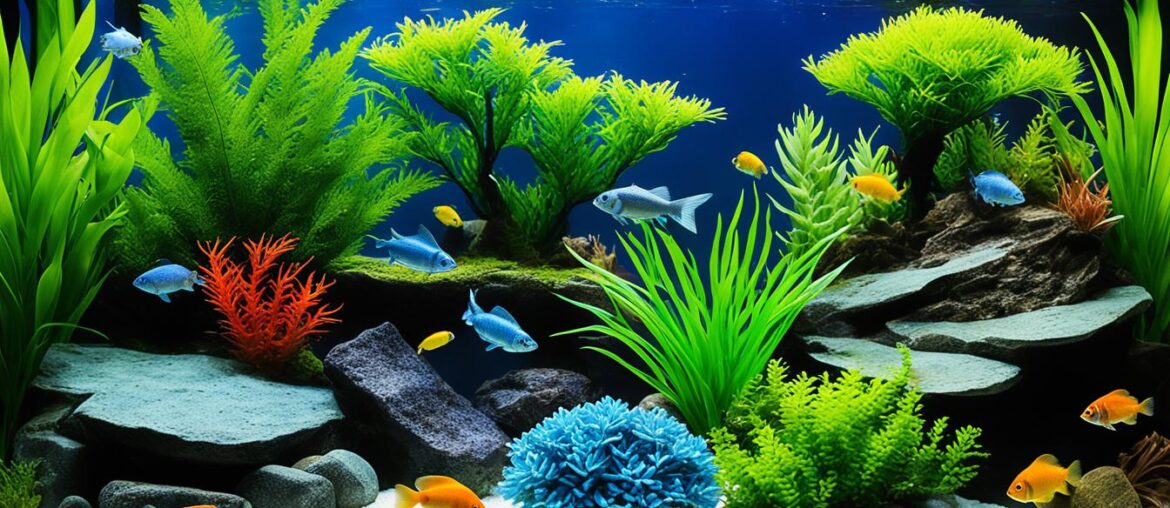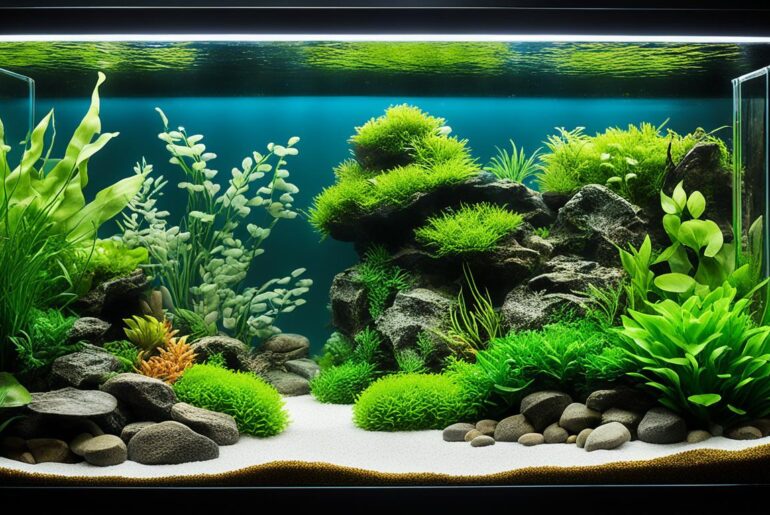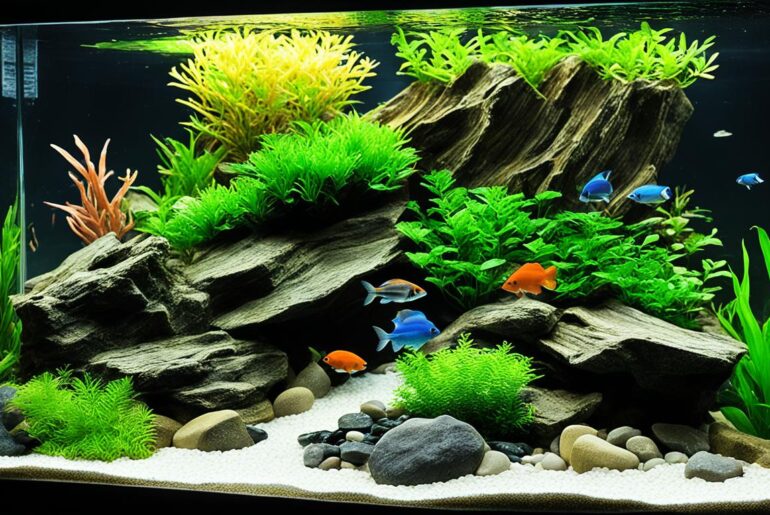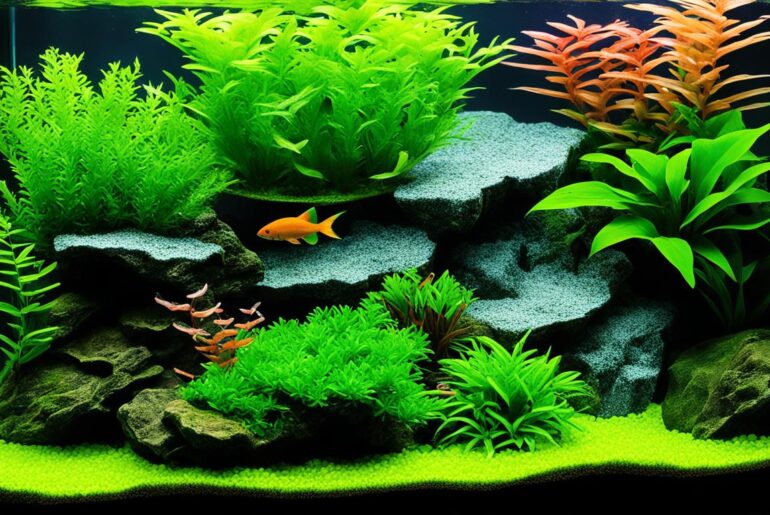Imagine walking into your fish room, the soft hum of bubbling water, and the gentle glow of your aquarium lights creating a serene atmosphere. As you approach your breeding tanks, you can’t help but feel a sense of excitement and anticipation. Today might be the day when new life emerges, tiny fry swimming amongst the carefully chosen substrates that provide them with a safe and nurturing environment.
For me, breeding freshwater fish has always been a labor of love, a way to connect with nature and witness the miracle of life unfolding before my eyes. But to ensure successful breeding, one must carefully consider the substrates chosen for the aquarium. These substrates play a vital role in creating a conducive environment for breeding, providing essential elements that promote spawning, shelter, and the overall well-being of the fry.
In this article, I will share with you the top 5 best substrates for successfully breeding freshwater fish. These substrates have been recommended by experts in the fishkeeping community and have proven their effectiveness time and time again. Whether you are an experienced breeder or just starting on your fish breeding journey, these substrates will help you create an ideal habitat for your breeding project.
Key Takeaways:
- Choosing the right substrate is crucial for successful breeding of freshwater fish
- Live aquarium plants, such as Java Moss and Water Sprite, serve as excellent substrates
- Other substrates like Guppy Grass, Mayaca fluviatilis, and various ferns can also enhance the breeding environment
- Proper maintenance and cleaning of substrates are essential for the health and well-being of both the fish and the breeding project
- By selecting the right substrates and maintaining them well, you can increase the chances of successful breeding and fry survival
Live Aquarium Plants as Substrates for Fish Breeding
Live aquarium plants are an excellent choice of substrates for fish breeding. They offer multiple benefits to both the breeders and the fish. Let’s explore why live plants make a great option for breeding fish.
Benefits of Live Plants for Fish Breeding
- Spawning Sites: Live aquarium plants provide suitable surfaces for fish to lay their eggs. The leaves and stems of these plants offer a safe and secure environment for spawning, increasing the chances of successful reproduction.
- Fry Shelter: Once the eggs hatch, the newly hatched fry require shelter to hide from adult fish and predators. Live plants offer ample hiding spots and cover, ensuring the survival of the fry during their vulnerable stages.
- Water Quality Maintenance: One of the significant advantages of using live plants as substrates is their ability to absorb excess nutrients and waste products in the water. They act as natural filters, helping maintain optimal water conditions for breeding fish.
- Microorganism Growth: Live plants promote the growth of beneficial microorganisms, such as infusoria and rotifers. These small organisms serve as a vital food source for newborn fry, providing them with essential nutrients.
Now, let’s take a look at some of the best live aquarium plants that serve as excellent substrates for fish breeding:
| Plant Name | Type | Care Level | Lighting |
|---|---|---|---|
| Java Moss | Moss | Easy | Low |
| Pogostemon stellatus ‘octopus’ | Stem Plant | Moderate | Medium |
| Water Sprite | Stem Plant | Easy | Medium |
| Guppy Grass | Stem Plant | Easy | Medium |
| Mayaca fluviatilis | Stem Plant | Moderate | Medium |
“Live aquarium plants provide spawning sites, shelter for fry, help maintain water quality, and promote the growth of microorganisms that serve as food for newborn fry.”
Having live aquarium plants as substrates for fish breeding can greatly enhance the breeding process and increase the chances of successful reproduction. These plants not only create a natural and comfortable environment for the fish but also contribute to the overall health and well-being of the aquatic ecosystem.
Java Moss as a Substrate for Fish Breeding
When it comes to creating an optimal breeding environment for freshwater fish, Java Moss is a substrate that stands out. With its lush, dense growth, Java Moss provides excellent cover for baby fish and shrimp, ensuring their safety and reducing stress levels. This versatile aquatic plant has many benefits that make it a favorite choice among fish breeders.
One of the key advantages of using Java Moss as a substrate is its ability to attract microorganisms. These microorganisms serve as a natural food source for fry, ensuring their nutritional needs are met during their early stages of development. Additionally, Java Moss’s fine texture provides a surface for eggs to stick to. This feature is particularly beneficial for fish species that lay adhesive eggs, as it helps protect the eggs from being consumed by adult fish.
Another advantage of Java Moss is its ease of growth and maintenance. It can thrive in low light conditions, making it suitable for aquariums with limited lighting options. Java Moss can be attached to various surfaces like driftwood or wire grids, allowing for creative placement within the tank. It also has a relatively fast growth rate, which helps in maintaining a healthy breeding environment.
To give you a visual idea of Java Moss’s dense growth and its benefits for fish breeding, take a look at the image below:
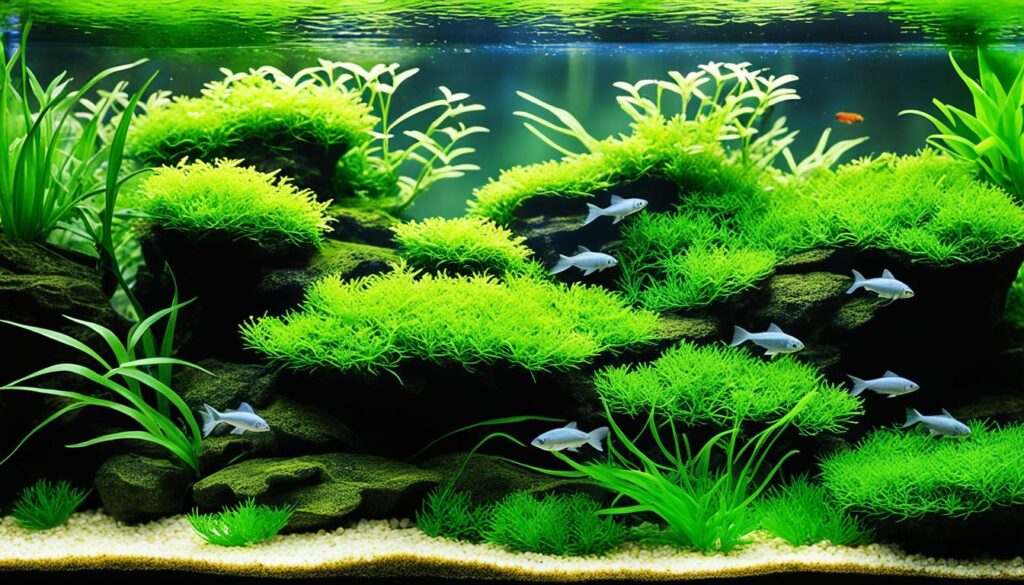
Java Moss as a Substrate – Key Benefits:
- Provides excellent cover for baby fish and shrimp
- Attracts microorganisms for fry to forage on
- Offers a surface for adhesive eggs to stick to
- Easily grows in low light conditions
- Can be attached to various surfaces
- Helps maintain a healthy breeding environment
In conclusion, using Java Moss as a substrate for fish breeding offers several advantages for both the breeders and the fish. Its dense growth, ability to attract microorganisms, and support for egg attachment make it an ideal choice. Furthermore, its easy maintenance and adaptability add to its appeal. Consider incorporating Java Moss into your breeding setup to create a thriving environment for your fish and their offspring.
Pogostemon stellatus ‘octopus’ as a Substrate for Fish Breeding
When it comes to creating an ideal breeding environment for freshwater fish, Pogostemon stellatus ‘octopus’ is a substrate that should definitely be considered. This fast-growing stem plant offers several benefits that can greatly enhance the success of fish breeding projects.
The long, wispy leaves of Pogostemon stellatus ‘octopus’ provide dense cover for fry, allowing them to hide from predators. The plant’s unique leaf structure creates small pockets of space that are only accessible to small fry, providing a safe haven and reducing the risk of predation. This allows for better survival rates and increased chances of successful breeding.
This plant can be grown submerged in aquariums and requires medium lighting and sufficient nutrients to thrive. It adds a beautiful aesthetic to the tank and contributes to overall water quality by absorbing excess nutrients and helping to maintain a healthy balance. By using Pogostemon stellatus ‘octopus’ as a substrate, you are not only providing a beneficial environment for fish breeding but also creating a visually appealing and vibrant aquarium.
With its unique characteristics and ability to create a safe and conducive breeding environment, Pogostemon stellatus ‘octopus’ is a highly recommended substrate for fish breeders. Its lush foliage and dense cover make it an excellent choice for both the well-being of the fish and the overall aesthetics of the aquarium.
Comparison of Substrates for Fish Breeding
| Substrate | Benefits |
|---|---|
| Pogostemon stellatus ‘octopus’ | Provides dense cover for fry to hide from predators |
| Java Moss | Excellent cover for baby fish and shrimp, attracts microorganisms for fry to forage on |
| Water Sprite | Creates shelter for small fish and shrimp, absorbs excess nutrients for water purification |
| Guppy Grass | Offers dense cover for fry to hide from adult fish |
| Mayaca fluviatilis | Provides a lush hiding spot for baby fish and shrimp |
“Pogostemon stellatus ‘octopus’ offers a unique and beneficial environment for fish breeding. Its dense cover and hidden spaces provide fry with a safe place to grow and develop. With the right lighting and nutrients, this substrate can truly transform your aquarium.” – Expert Breeder
Water Sprite as a Substrate for Fish Breeding
Water Sprite is a highly sought-after substrate among fish breeders. This fast-growing stem plant not only enhances the visual appeal of your aquarium but also offers numerous benefits for breeding fish.
One of the key advantages of using Water Sprite as a substrate is its ability to purify water by absorbing excess nutrients. This helps maintain a healthy and clean environment for your fish to thrive in.
When planted in the ground, Water Sprite forms a tall, bushy mound with fine, lacy leaves. These dense foliage provides excellent shelter and hiding spots for small fish and shrimp, creating a natural and secure habitat for breeding.
Alternatively, growing Water Sprite as a floating plant yields wider leaves with rounded tips and thick roots. These attributes make it an ideal substrate for fish to lay their eggs onto, while the fry can freely graze on the nutritious plants.
Whether used as a planted or floating substrate, Water Sprite offers both aesthetic appeal and functional benefits for fish breeding. Its ability to absorb excess nutrients, provide shelter, and serve as a food source makes it a popular choice among aquarists.
![]()
“Water Sprite is a versatile and beneficial substrate for fish breeding. Its lush foliage offers protection and nourishment for both adult fish and their fry, creating an ideal breeding environment.”
Guppy Grass as a Substrate for Fish Breeding
When it comes to breeding fish, choosing the right substrate is essential. One option that stands out is Guppy Grass, also known as Najas guadalupensis. This versatile plant can serve as an excellent substrate for fish breeding, offering a range of benefits that contribute to the successful rearing of offspring.
Guppy Grass can be grown as a floating mass of plant matter, creating a dense cover for fry to hide from adult fish. The closely spaced tufts of short, narrow leaves make it difficult for most adult fish to penetrate, providing ideal protection for vulnerable fry. This natural hiding place allows the fry to grow safely and increases their chances of survival.
One of the advantages of using Guppy Grass as a substrate is its ease of propagation. This plant can quickly multiply, ensuring a steady supply of cover for fry. Its fast growth rate makes it a reliable and efficient choice for breeding setups. However, it’s worth noting that Guppy Grass may not be suitable for high flow tanks, as the plants may struggle to remain rooted under strong water currents.
In addition to its practical benefits, Guppy Grass adds aesthetic appeal to aquariums. The vibrant green color and delicate foliage create a visually pleasing underwater landscape, enhancing the overall beauty of the tank.
Benefits of Guppy Grass for Fish Breeding:
- Provides dense cover for fry to hide from adult fish
- Easy to propagate and maintain
- Enhances the aesthetics of the aquarium
- Creates a natural and safe environment for fish breeding
In conclusion, Guppy Grass serves as an excellent substrate for fish breeding. Its ability to provide dense cover for fry, easy propagation, and aesthetic appeal make it a valuable addition to any breeding setup. By incorporating Guppy Grass into your aquarium, you can create a conducive environment for successful fish breeding and increase the chances of fry survival.
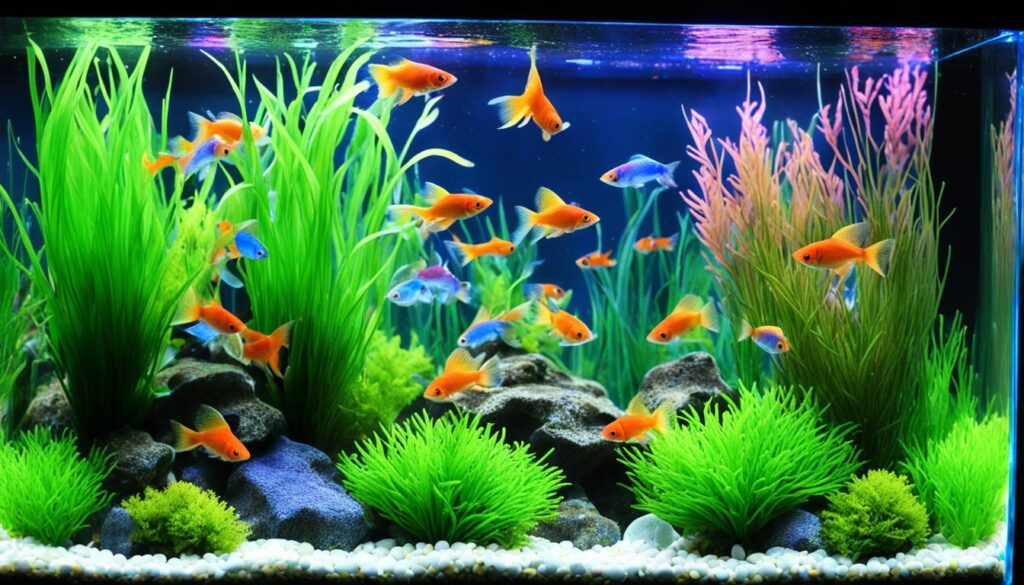
Mayaca fluviatilis as a Substrate for Fish Breeding
Mayaca fluviatilis is an exceptional plant that adds unique textures and visual interest to a planted aquarium. Its slender stem is adorned with fine, small leaves, resembling a yellow-green pipe cleaner. This distinct appearance makes it an attractive addition to any aquascape.
When used as a substrate for fish breeding, Mayaca fluviatilis offers several benefits. Its dense foliage creates a lush hiding spot for baby fish and shrimp, providing them with a secure environment to thrive. The intricate structure of its leaves offers ample cover for the fry and reduces stress by mimicking the natural habitats they would seek in the wild.
This plant prefers a medium lighting level to exhibit its full potential. Placed in an appropriate light, Mayaca fluviatilis will flourish and add vibrancy to the aquarium. Additionally, liquid fertilizer can be used to provide essential nutrients and promote optimal growth.
The combination of Mayaca fluviatilis’ distinctive appearance, ability to provide shelter, and preference for medium lighting make it a valuable substrate for fish breeding tanks. With these features, it can contribute to the overall success of a breeding project and the health and well-being of the fish.
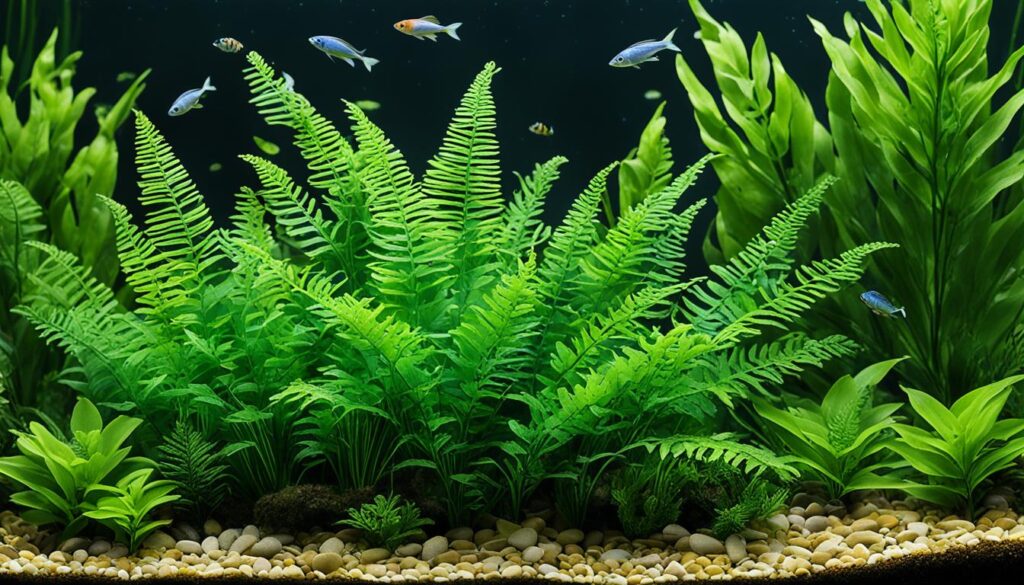
Note: The image above showcases Mayaca fluviatilis in a planted aquarium, showcasing its unique texture and visual appeal.
Other Substrates for Fish Breeding
In addition to the plants mentioned above, there are other substrates that can be beneficial for fish breeding. These substrates offer unique advantages in terms of providing cover, food sources, and natural environments for breeding fish. Here are some of the noteworthy options:
Vallisneria
Vallisneria is a popular substrate choice for fish breeding due to its long and vibrant leaves. The dense foliage provides excellent hiding spots for fry and adds visual appeal to the aquarium. Vallisneria also helps in maintaining water quality by absorbing excess nutrients.
Hydrocotyle tripartita ‘Japan’
Hydrocotyle tripartita ‘Japan’ is a versatile substrate that can be grown as a carpeting plant or attached to hardscape elements. It forms a dense mat with small, round leaves that create a natural landscape for fish to breed. This substrate also promotes the growth of beneficial microorganisms.
Bolbitis Fern
Bolbitis Fern is an attractive and low-maintenance substrate that enhances the aesthetics of any aquarium. It features lacy, textured leaves that provide small fish and fry with plenty of hiding spots. This substrate requires low to moderate lighting and can be attached to driftwood or rocks.
Pearl Weed
Pearl Weed, or Hemianthus micranthemoides, is a versatile plant that can be used as a carpeting substrate or allowed to grow vertically. Its vibrant green leaves provide ample cover for fry, making it an ideal substrate for breeding fish. Pearl Weed thrives in moderate to high lighting conditions.
Frogbit
Frogbit is a floating plant that adds beauty to the aquarium while offering numerous benefits for fish breeding. Its long roots provide cover for fry, and the plant also absorbs excess nutrients from the water, reducing the risk of algae growth. Frogbit prefers moderate lighting conditions.
These substrates can be used individually or in combinations to create a diverse and stimulating environment for breeding fish. They offer various advantages, such as providing hiding spots, promoting water quality, and enhancing the overall aesthetics of the aquarium.
| Substrate | Benefits |
|---|---|
| Vallisneria | Provides hiding spots for fry and maintains water quality. |
| Hydrocotyle tripartita ‘Japan’ | Creates a natural landscape and supports beneficial microorganisms. |
| Bolbitis Fern | Enhances aesthetics and offers hiding spots for small fish. |
| Pearl Weed | Provides cover and can be used as a carpeting substrate. |
| Frogbit | Offers cover and absorbs excess nutrients from the water. |
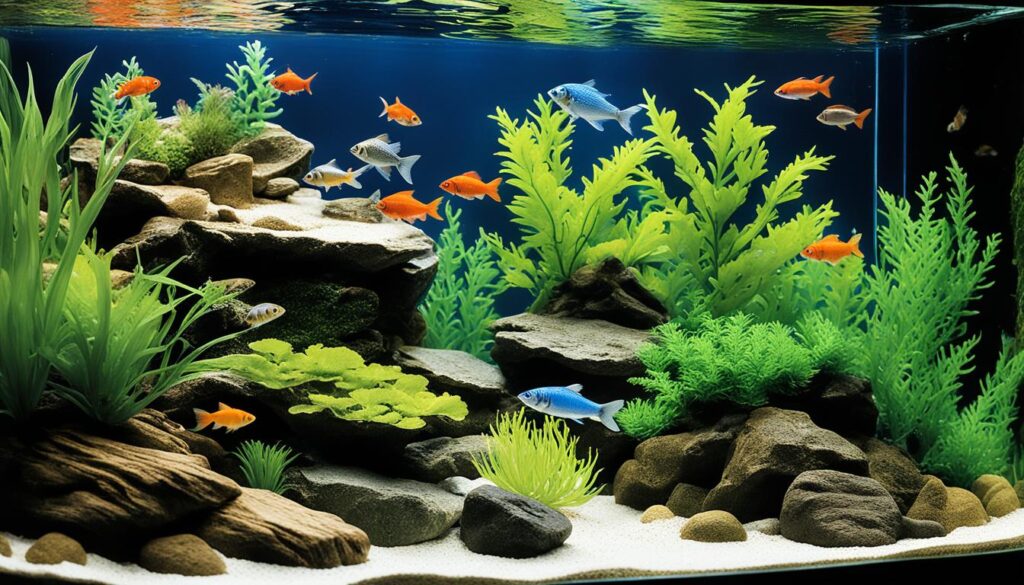
By selecting the right substrates for fish breeding, you can create a suitable environment that encourages successful breeding and the survival of fry. These substrates not only serve practical purposes but also add beauty and natural elements to the aquarium, enhancing the overall fishkeeping experience.
The Importance of Substrates for Freshwater Fish Breeding
When it comes to breeding freshwater fish, the choice of substrate is of utmost importance. Substrates play a vital role in providing the necessary conditions for successful breeding and the overall well-being of the fish. They offer a range of benefits that contribute to the breeding process, helping to create an ideal environment for fish reproduction and fry survival.
One of the primary functions of substrates in fish breeding is providing spawning sites. Various substrates, such as gravel, sand, or plant materials, offer suitable surfaces for fish to lay their eggs. These spawning sites not only facilitate the breeding process but also protect the eggs from external threats, ensuring a higher rate of fertilization and hatch success.
Furthermore, substrates serve as essential shelters for fry. Newly hatched fish fry are highly vulnerable to predation, and having adequate hiding places is crucial for their survival. Substrates, particularly those with intricate structures like plants, provide secure hiding spots where fry can seek refuge until they grow larger and more resilient.
“Having suitable substrates in the breeding tank allows fish to exhibit their natural behaviors, promoting overall health and well-being.”
In addition to their role in spawning and fry protection, substrates contribute to water purification. They act as a medium for beneficial bacteria to colonize, facilitating the biological filtration process. These bacteria break down harmful ammonia and convert it into less toxic substances, ensuring optimal water quality for the fish and their young.
By creating a natural environment, substrates enable fish to exhibit their natural behaviors, which is essential for successful breeding. Fish feel more secure and comfortable in an environment that closely mimics their natural habitat, increasing the likelihood of courtship and successful spawning. Substrates also provide surfaces for fish to exhibit certain behaviors, such as digging or nest building, which are important aspects of their reproductive cycle.
The importance of substrates for freshwater fish breeding cannot be overstated. They play a crucial role in providing spawning sites, shelter for fry, and contribute to water purification. With the right substrates in place, fish are more likely to exhibit natural behaviors, leading to successful breeding and increased fry survival.
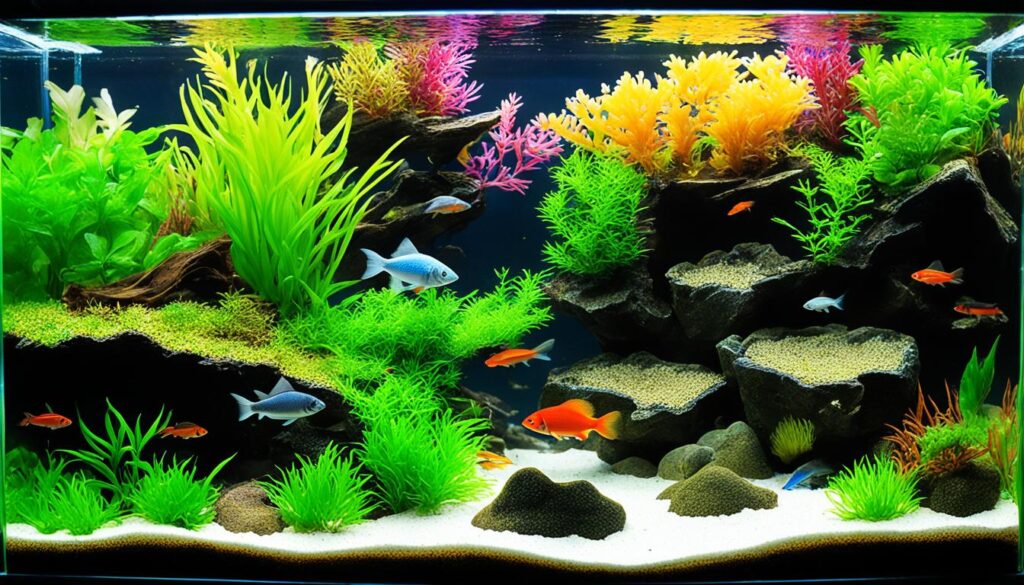
| Benefits of Substrates for Freshwater Fish Breeding |
|---|
| Provides spawning sites for fish |
| Offers shelter for fry, increasing their survival rate |
| Contributes to water purification by facilitating biological filtration |
| Creates a natural environment for fish, promoting natural behaviors |
Maintaining and Cleaning Aquarium Substrates for Fish Breeding
As an avid fish breeder, I understand the importance of maintaining and cleaning aquarium substrates. Proper care for fish breeding substrates not only ensures the health and well-being of your fish but also contributes to a successful breeding environment. Different substrates require different maintenance routines, so let’s dive into the specifics.
Gravel Substrates
Gravel substrates are a popular choice among fish breeders due to their versatility and aesthetic appeal. However, they can accumulate debris over time, which may negatively impact water quality. To maintain a clean gravel substrate:
- Regularly use a gravel vacuum to remove waste and debris that settle between the gravel particles.
- Focus on areas where uneaten food or plant matter tends to collect.
- Perform partial water changes to refresh the substrate and remove any excess nutrients.
Live Plant Substrates
Using live plants as substrates offers numerous benefits for fish breeding. These plants not only provide a natural and aesthetic environment but also contribute to water purification. Here are some care tips for maintaining live plant substrates:
- Trim the plants regularly to prevent overgrowth and ensure adequate light penetration.
- Fertilize the substrate with a suitable plant fertilizer to provide essential nutrients for plant growth.
- Monitor water parameters such as pH, temperature, and nutrient levels to ensure optimal conditions for the plants and the fish.
Remember, maintaining a healthy substrate is crucial for the overall well-being of your fish and their breeding success. By keeping the substrate clean and monitoring water parameters, you can create an ideal environment for your fish to thrive.
Here’s a visual representation to summarize the maintenance routines for different substrates:
| Substrate Type | Maintenance Tips |
|---|---|
| Gravel | Regular vacuuming, partial water changes |
| Live Plants | Trimming, fertilization, monitoring water parameters |
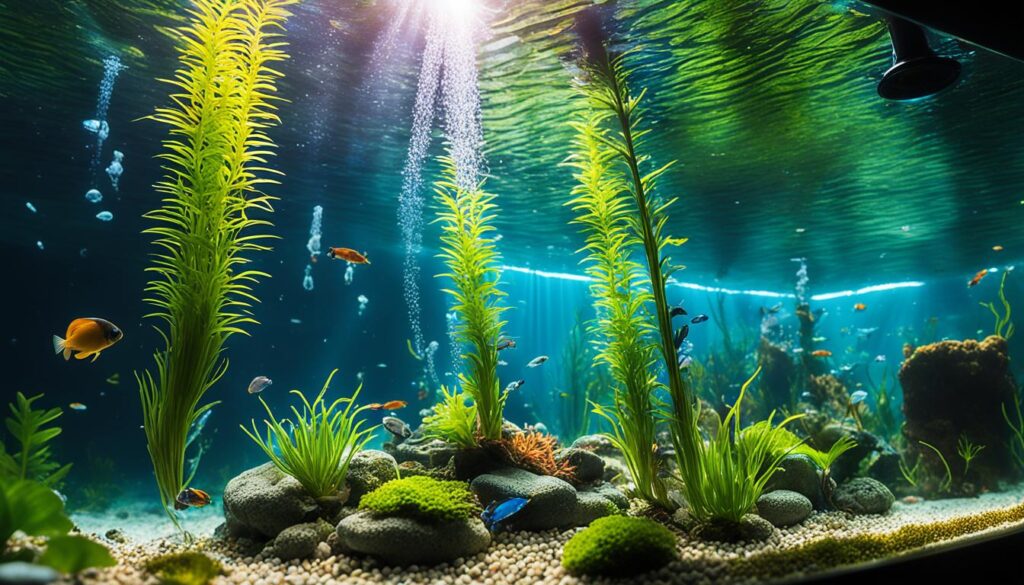
Maintaining and cleaning your aquarium substrates is an essential aspect of fish breeding. By following these care tips, you can promote a healthy breeding environment and increase the chances of successful breeding and fry survival.
Conclusion
After considering the top substrates for freshwater fish breeding, it is clear that live aquarium plants, such as Java Moss and Water Sprite, offer numerous benefits. These plants provide essential shelter for fry, serve as food sources, and contribute to water purification in the breeding environment. Additionally, substrates like Guppy Grass, Mayaca fluviatilis, and various ferns can further enhance the breeding setup.
It is crucial to properly maintain and clean the substrates to ensure the health and well-being of both the fish and the overall breeding project. This includes regular vacuuming of gravel substrates to remove debris and appropriate trimming and fertilization of live plant substrates. Monitoring water parameters is also essential to uphold the substrate’s health and the successful breeding of fish.
By carefully selecting the right substrates and maintaining them adequately, breeders can significantly increase the chances of successful fish breeding and enhance the survival rate of fry in the freshwater aquarium. Remember, choosing the best substrates is crucial for the success of your breeding project, and proper maintenance is the key to a thriving fish breeding setup.
FAQ
What are the best substrates for breeding freshwater fish?
The top substrates for breeding freshwater fish include live aquarium plants, such as Java Moss, Pogostemon stellatus ‘octopus’, Water Sprite, Guppy Grass, and Mayaca fluviatilis.
Why are live aquarium plants recommended as substrates for fish breeding?
Live aquarium plants provide spawning sites, shelter for fry, help maintain water quality, and promote the growth of microorganisms that serve as food for newborn fry. They also create a natural environment for fish to exhibit natural behaviors, increasing the chances of successful breeding and fry survival.
What are the benefits of using Java Moss as a substrate for fish breeding?
Java Moss is a dense plant that provides excellent cover for baby fish and shrimp. It attracts microorganisms for fry to forage on and has tendrils that eggs can stick to. It is easy to grow, requires low light, and can be attached to various surfaces like driftwood or wire grids.
How does Pogostemon stellatus ‘octopus’ serve as a substrate for fish breeding?
Pogostemon stellatus ‘octopus’ is a fast-growing stem plant that provides dense cover for fry to hide from predators. Its long, wispy leaves create pockets of space accessible only to small fry. It can be grown submerged and requires medium lighting and sufficient nutrients to thrive.
What role does Water Sprite play as a substrate for fish breeding?
Water Sprite is a fast-growing stem plant that helps purify water by absorbing excess nutrients. When planted in the ground, it forms a tall, bushy mound with fine, lacy leaves that provide shelter for small fish and shrimp. As a floating plant, it develops wide leaves with rounded tips and thick roots for fish to lay eggs and fry to graze on.
How does Guppy Grass benefit fish breeding as a substrate?
Guppy Grass, also known as Najas guadalupensis, can be grown as a floating mass of plant matter, providing dense cover for fry to hide from adult fish. Its closely spaced tufts of short, narrow leaves make it impenetrable for most adult fish. It is easy to propagate but may not be suitable for high flow tanks.
What advantages does Mayaca fluviatilis offer as a substrate for fish breeding?
Mayaca fluviatilis is a unique plant that provides interesting textures in a planted aquarium. Its fine, small leaves resemble a yellow-green pipe cleaner, offering a lush hiding spot for baby fish and shrimp. It prefers medium lighting and liquid fertilizer for optimal growth.
Are there any other substrates that can be beneficial for fish breeding?
Yes, there are other substrates that can enhance fish breeding, such as Vallisneria, Hydrocotyle tripartita ‘Japan’, Bolbitis Fern, Pearl Weed, and Frogbit. Each of these substrates provides unique benefits, including cover, food sources, and natural environments for fish breeding.
What is the importance of substrates in freshwater fish breeding?
Substrates provide spawning sites, shelter for fry, and contribute to water purification. They also create a natural environment for fish, allowing them to exhibit natural behaviors and increasing the chances of successful breeding and fry survival.
How should I maintain and clean aquarium substrates for fish breeding?
Different substrates require different maintenance routines. Gravel substrates need regular vacuuming to remove debris, while live plant substrates may require trimming and fertilization. It is also important to monitor water parameters to ensure the health of the substrate and the fish.
